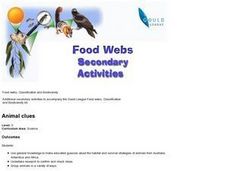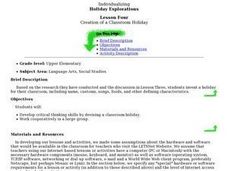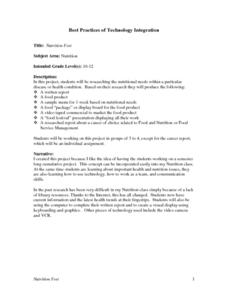Curated OER
Basic Needs
Young scholars examine the unique and diverse historical artifacts that people have designed to fulfill their everyday needs in extraordinary ways. They identify ways humans have used design throughout history to enhance the ways they...
Curated OER
EEEK! A Spider!
Youngsters complete a unit of lessons based on the story "Little Miss Muffet." They predict what will happen in the story, and use context clues to look for meaning in the words. They research information about spiders using the Internet...
Curated OER
Ecology
Fourth graders research an ecosystem and its endangered species. They create a PowerPoint Presentation, oral report, poster or a booklet based on their research. They research on the internet and in biology texts in teams of 4.
Curated OER
Animal clues
Fifth graders use general knowledge to make educated guesses about the habitat and survival strategies of animals from Australia, Antarctica and Africa. They research to confirm and check ideas and group animals in a variety of ways.
Curated OER
Survival
Students identify characteristics of Australia, Africa and Antarctica and compare and contrast them to each other. They work together to identify adaptations that animals have used to survive. They also practice classifying animals.
Curated OER
Belonging and Identity
Students participate in a class in which they eat in different social groups. As a class, they discuss the importance of eating a healthy diet and how some foods are harmful to some but not to others. They use the internet to research...
Curated OER
Who Ate it First?
Students complete the Seeds of Change worksheet by conducting research on the Seeds of Change website. They list foods native to the Eastern and Western hemispheres, and compile a list of recipes for a meal common after the era of...
Curated OER
CREATING A CLASSROOM HOLIDAY
Students invents a holiday for their classroom, including name, customs, songs, foods, and other defining characteristics based on the research they have conducted and the discussion in Lesson Three.
Curated OER
Nutrition Fest
Students explore the nutritional needs within a particular disease or health condition. They create a a written report, a food product and a sample menu for one week based on nutritional needs. Students create a food package or display...
Curated OER
Life Cycles
Using computers, Students work in small groups and progress through the roles of Explorer, Researcher, Designer, and Evaluator as they study the life cycle of plants, insects, butterflies and frogs.
Curated OER
A Taste of France: Le Fromage
Students in a French class examine the customs related to eating food. In groups, they use the internet to visit a variety of websites to discover how to properly eat cheese, how it is made and what role it plays in meals. they also...
Curated OER
Yuckiest Site on the Internet
Students investigate the worm and the cockroach. In this organisms instructional activity, students visit suggested websites to identify the characteristics of worms and cockroaches. Students dissect a worm and observe a live...
Curated OER
Travel to Europe
Students work in small groups to plan an imaginary trip to Europe, including Germany. They research travel routes, prices and popular sights of each destination. Students assemble a booklet describing their itinerary, budget, packing...
Curated OER
Cancer-Fighting Foods and Health
Students will locate designated URL's to learn more about cancer protective foods. They will inventory their own dietary habits and that of their family to see which of these foods they have eaten and which are regular parts of their diet.
Curated OER
Resource Based Learning Unit Using Mad Cow Disease
Students research the topic of mad cow disease. They use an internal research network to search for newspaper and magazine articles about the disease. They are to evaluate the information they find and determine if it is creditable.
Curated OER
Food Ways - Graphing
Sixth graders choose the appropriate graph to display collected data. They interview each other on what foods they eat. They also interview elders and find out what types of food they grew up eating. They create graphs to display the...
Curated OER
Explore a Family Recipe Creative Writing
Students explore the connections between food and culture by investigating the cultural influences, preparation, and historical ties of the food that people eat. They comprehend how geography and climate effects what people eat...
Curated OER
Burn Baby Burn
Pupils use the Internet to research information on the food pyramid, recommended daily allowances of nutrients, caloric intake and expenditure, and value of foods. They analyze their own eating habits and exercise level.
Curated OER
Mathematics & Nutrition
Students apply math to calculate fat and calories in the food they eat. They examine food package information to become aware of the ingredients and to learn about healthy life styles. They work in groups to create crazy meals using the...
Curated OER
Local Animal Sort
Students examine the concepts of sorting and classifying animal. They use familiar animals to determine the connections between physical characteristics and categorization.
Curated OER
When Something's Missing: Diagnosing Vitamin Deficiencies
The New York Times "Education" section posts an extensive instructional activity on vitamin and mineral deficiencies. It involves class discussion, examination of food packaging labels, and the reading of a blog post about Vitamin D. The...
Curated OER
Learning About the Kumeyaay Indians
Third graders research the Native American nation of Kumeyaay. Scholars use the internet to research past history. Through email, 3rd graders communicate with a Kumeyaay child to discover life on a present day reservation. They create a...
Curated OER
Creating a Wild Family Album
Third graders choose an animal to research and create a portfolio about that animal that includes information from at least three resources, a graphic organizer, maps, food webs, and captioned pictures.
Curated OER
Prosperity and Challenges
Students watch a slideshow about the technological advances in agriculture. After viewing, they complete an index card about one aspect of the slideshow. In groups, they create a cause and effect timeline in which they identify specific...

























